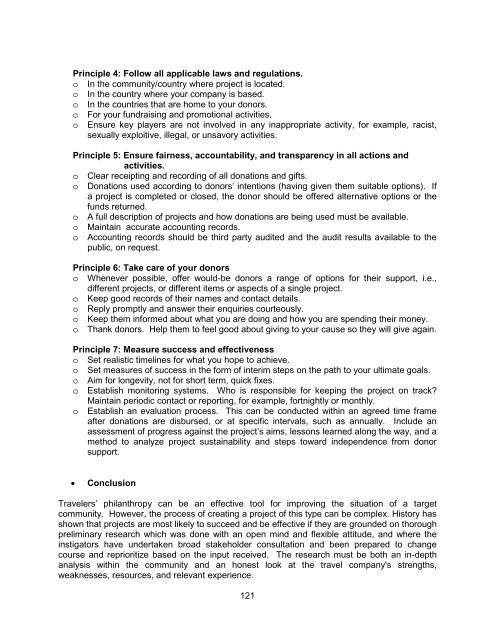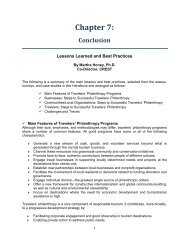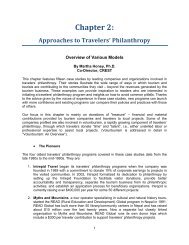Travelers' Philanthropy Handbook - Center for Responsible Travel
Travelers' Philanthropy Handbook - Center for Responsible Travel
Travelers' Philanthropy Handbook - Center for Responsible Travel
You also want an ePaper? Increase the reach of your titles
YUMPU automatically turns print PDFs into web optimized ePapers that Google loves.
Principle 4: Follow all applicable laws and regulations.o In the community/country where project is located.o In the country where your company is based.o In the countries that are home to your donors.o For your fundraising and promotional activities.o Ensure key players are not involved in any inappropriate activity, <strong>for</strong> example, racist,sexually exploitive, illegal, or unsavory activities.Principle 5: Ensure fairness, accountability, and transparency in all actions andactivities.o Clear receipting and recording of all donations and gifts.o Donations used according to donors’ intentions (having given them suitable options). Ifa project is completed or closed, the donor should be offered alternative options or thefunds returned.o A full description of projects and how donations are being used must be available.o Maintain accurate accounting records.o Accounting records should be third party audited and the audit results available to thepublic, on request.Principle 6: Take care of your donorso Whenever possible, offer would-be donors a range of options <strong>for</strong> their support, i.e.,different projects, or different items or aspects of a single project.o Keep good records of their names and contact details.o Reply promptly and answer their enquiries courteously.o Keep them in<strong>for</strong>med about what you are doing and how you are spending their money.o Thank donors. Help them to feel good about giving to your cause so they will give again.Principle 7: Measure success and effectivenesso Set realistic timelines <strong>for</strong> what you hope to achieve.o Set measures of success in the <strong>for</strong>m of interim steps on the path to your ultimate goals.o Aim <strong>for</strong> longevity, not <strong>for</strong> short term, quick fixes.o Establish monitoring systems. Who is responsible <strong>for</strong> keeping the project on track?Maintain periodic contact or reporting, <strong>for</strong> example, <strong>for</strong>tnightly or monthly.o Establish an evaluation process. This can be conducted within an agreed time frameafter donations are disbursed, or at specific intervals, such as annually. Include anassessment of progress against the project’s aims, lessons learned along the way, and amethod to analyze project sustainability and steps toward independence from donorsupport.• Conclusion<strong>Travel</strong>ers’ philanthropy can be an effective tool <strong>for</strong> improving the situation of a targetcommunity. However, the process of creating a project of this type can be complex. History hasshown that projects are most likely to succeed and be effective if they are grounded on thoroughpreliminary research which was done with an open mind and flexible attitude, and where theinstigators have undertaken broad stakeholder consultation and been prepared to changecourse and reprioritize based on the input received. The research must be both an in-depthanalysis within the community and an honest look at the travel company's strengths,weaknesses, resources, and relevant experience.121















